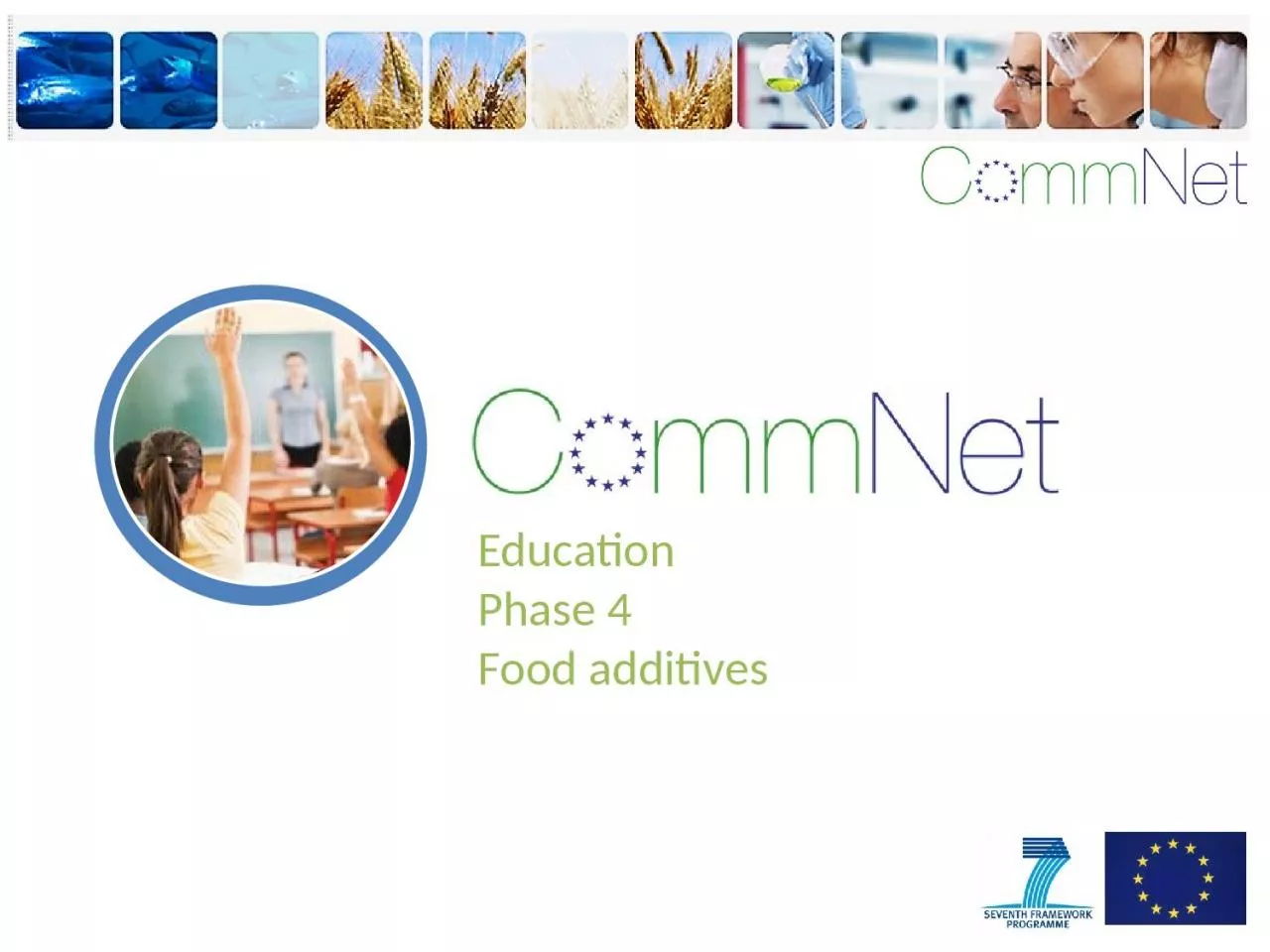

Additives are substances used for a variety of reasons such as preservation colouring sweetening during the preparation of food The European Union legislation defines them as ID: 918450
Download Presentation The PPT/PDF document "Education Phase 4 Food additives" is the property of its rightful owner. Permission is granted to download and print the materials on this web site for personal, non-commercial use only, and to display it on your personal computer provided you do not modify the materials and that you retain all copyright notices contained in the materials. By downloading content from our website, you accept the terms of this agreement.
Slide1
Education
Phase 4
Food additives
Slide2Additives
are substances used for a variety of reasons
such
as preservation, colouring, sweetening,
during
the preparation of food.
The
European Union legislation defines them
as:
"any substance not normally consumed as a food in itself and not normally used as a characteristic ingredient of food whether or not it has nutritive value, the intentional addition of which to food for a technological purpose results in it or its by-products becoming directly or indirectly a component of such
foods“.
Slide3The EU legislation
states
that food
additives must have advantages and benefits for the consumer. Therefore, they have to do one of the following:
preserve the nutritional quality of the food;provide necessary ingredients or constituents for foods manufactured for people with
special dietary needs;enhance the keeping quality or stability of a food or improving its organoleptic properties, provided that the consumer is not misled;aid the manufacture, processing, preparation, treatment, packing, transport or storage of food, including food additives, food enzymes and food flavourings, provided that the food additive is not used to disguise faulty raw materials or cover up unhygienic practices.
Slide4All additives are thoroughly assessed for safety before they
can be used.
They
are only then permitted to be used in a limited range of products and in certain amounts.
These
amounts are based on an Acceptable Daily Intake (ADI) calculated by the European Food Safety Authority (EFSA) from the results of safety tests.
The
ADI represents an amount that can be ingested daily over a lifetime without appreciable health risk.
Approved
additives are given a number and some are also awarded an ‘E’. An E shows the additive has been accepted as safe for use within the European Union.
Even
when an additive has been approved, regular repeat testing is required to maintain its status as ‘approved’.
Slide5Food additives are
:
Sweeteners
-
to sweeten foods or in table-top sweeteners;
Colours
- adding or restoring colour in a food;
Preservatives
-
prolonging shelf-life of foods by protecting them against deterioration by micro-organisms;
Antioxidants
-
prolonging shelf-life of foods by protecting them against oxidation e.g. fat rancidity, colour changes;
Stabilisers
-
to maintain the
physical-chemical
state of a foodstuff;
Emulsifiers
-
to maintain the mixture of oil and water in a foodstuff
.
Slide6Additives may be:
natural
– found naturally, such as extracts from beetroot juice (E162), used as a colouring agent;manmade
versions – synthetic identical copies of substances found naturally, such as benzoic acid (E210), used as a preservative;
artificial – produced synthetically and not found naturally, such as nisin (E234), used as a preservative in some dairy
products.
Types of additives
Slide7Sweeteners include:
intense
sweeteners, e.g. saccharin, have a sweetness many times that of sugar and therefore are used in small amounts, e.g. in diet foods, soft drinks, sweetening
tablets.
Also
known as artificial sweeteners, examples include aspartame,
acesulfame
K, saccharin, sucralose and stevia.
bulk
sweeteners, e.g. sorbitol, Bulk sweeteners provide fewer calories weight for weight compared to sugar, but have a similar bulk or volume
.
These
are useful, for example, when preparing low calorie confectionery products.
Sweeteners
Slide8What are the potential benefits of sweeteners?
The use of low calorie sweeteners may offer benefits in relation
to:
weight management
diabetes
management
dental
health.
For
example, in relation to weight management, the use of sweeteners can help people to control their
energy
intake.
Slide9Food colours
Colours
are
used to make food look more appetizing. During the processing of some food, colour can be lost so additives are used to restore the original colour, for example canned marrow fat peas.
Colour
additives can also be used to make the existing food colour brighter, for example, enhance the yellowness of custard.
Colours
are either natural (e.g.
curcumin
(E100) is a yellow extract of turmeric roots), nature identical or artificial. Some colours are also vitamins (e.g. riboflavin and beta-carotene) and these are the only colours allowed in baby food.
Slide10Preservatives
Preservatives are
used to help keep food safe to eat for longer.
Any
processed food with a long shelf-life is likely to include preservatives, unless another way of preservation has been used, such as freezing, canning or drying.
Traditional
methods using sugar, salt and vinegar are still used to preserve
foods
.
Slide11Antioxidants
Decrease
the chance of oils and fats in foods from combining with oxygen and changing colour or turning rancid.
Rancid
fats smell and taste unpleasant and are a health risk.
Antioxidants are also used
to prevent
the browning of cut fruit, vegetables and fruit juices (and so increase shelf life and appearance).
For example, vitamin C, also known as ascorbic acid, or E300, is one of the most widely used antioxidants.
Slide12Emulsifiers, stabilisers, gelling agents, thickeners
Emulsifiers help mix ingredients together that would normally separate, e.g.
lecithins
(E322).
Stabilisers prevent ingredients from separating again, e.g. locust bean gum (E410).
Emulsifiers
and stabilisers give food a consistent texture, e.g.
in
low-fat spreads.
Gelling agents are used to change the consistency of a food, e.g. pectin (E440), which is used to make jam.
Thickeners help give food body, e.g. can be found in most sauces.
Slide13Anti-caking
agents
Anti-foaming
agents
Anti-foaming agents prevent or disperse frothing, e.g. in the production of fruit juices.
Anti-caking agents ensure free movement or flow of particles, e.g.
in
dried milk or table salt.